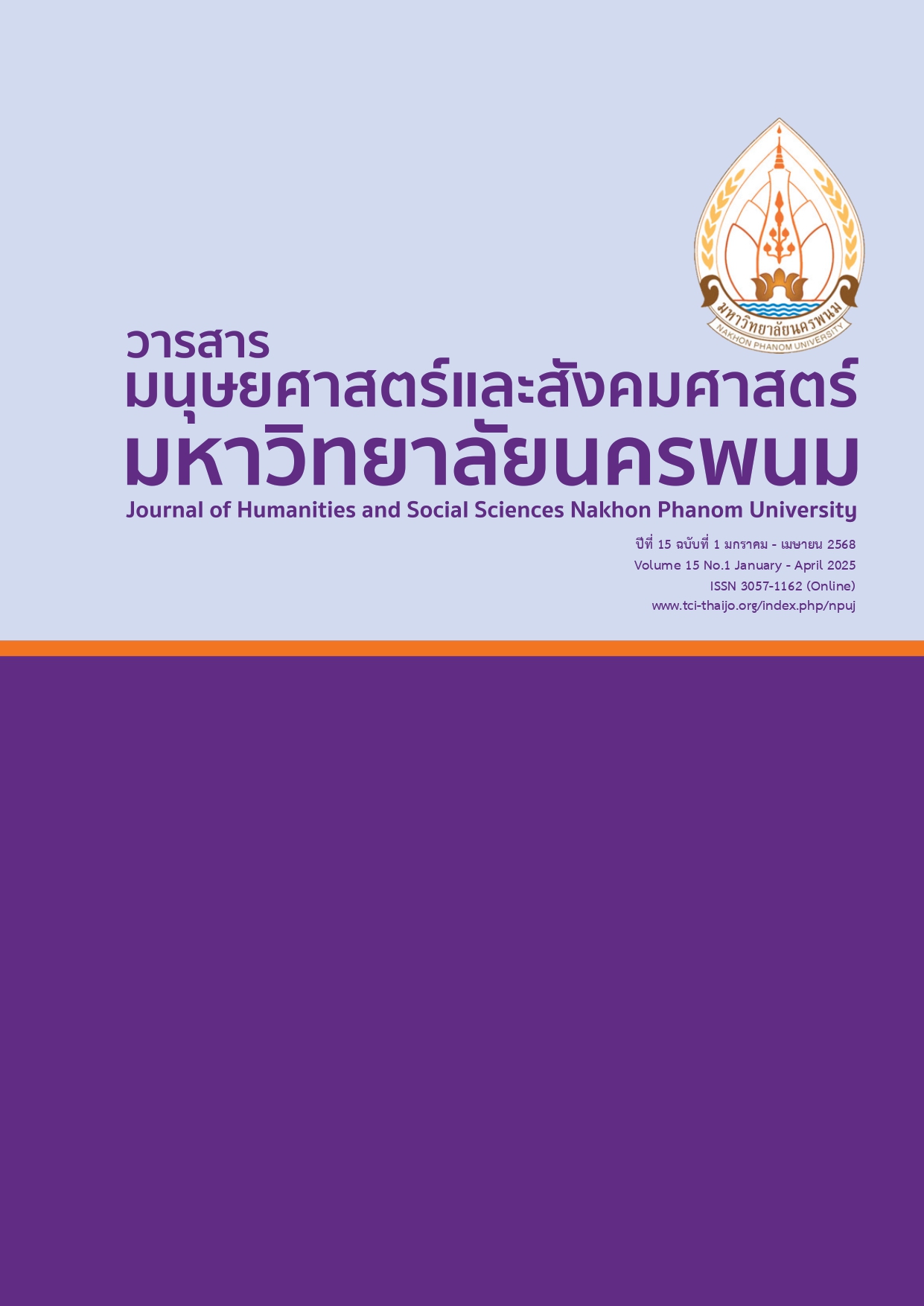Strengthening Skills in Understanding and Using Digital Technology Through a Training Model Based on the Concept of Collaborative Learning to Enhance the Digital Competence of Songkhla Municipality School Teacher
Main Article Content
Abstract
This research aimed to study the problems and needs in strengthening the skills of understanding and using digital technology, develop a training model based on the collaborative learning concept, study the effects of using the training model based on the collaborative learning concept, and evaluate the aforementioned training model. The research and development method consisted of 4 steps: Step 1: Study the problems and needs in strengthening the skills of understanding and using digital technology; Step 2: Develop a training model based on the collaborative learning concept; Step 3: Study the effects of using the training model based on the collaborative learning concept; Step 4: Evaluate the training model based on the collaborative learning concept.The sample consisted of 147 teachers of Songkhla Municipality School, using multi-stage random sampling and five experts using purposive sampling.The research instruments included a questionnaire on problems and needs of training models, a training model, collaborative learning behaviors and satisfaction assessment form. The statistics used in this research were mean, percentage, standard deviation, and t-test dependent. The research results revealed that 1. The overall level of problems and needs was high. 2. The training model consists of the following components: 1) Context, 2) Input, 3) Process, 4) Output, and 5) Feedback; it comprises four main stages including: 1) Pre-training stage, 2) Training implementation stage, 3) Evaluation stage, and 4) Post-training follow-up stage. The effectiveness of the training model, as measured by the E1/E2 efficiency index, was found to be 82.27/83.17. 3. The skills of understanding and using digital technology were higher than the 80 percent criterion with statistical significance at the 0.01 level. The overall collaborative learning behavior was at the highest level, the overall satisfaction was at the highest level, and 4. The overall appropriateness of the training model was at the highest level.
Article Details

This work is licensed under a Creative Commons Attribution-NonCommercial-NoDerivatives 4.0 International License.
References
Bangmo, S. (2006). Training and meeting techniques (3rd ed.). Witthayaphat.
Bawden, D. (2008). Origins and concepts of digital literacy. In C. Lank shear & M. Knobel (Eds.), Digital literacies: Concepts, policies & practices, (pp. 17-32). Peter Lang.
Boason, R. (2009). Research and Development of Educational Innovations. Kamsamai.
Brahmawong, C. (2010). Compilation of educational system organization courses. Sukhothai Thammathirat Open University.
Chulasap, N. (2008). Group relations for training (5th ed.). Namsilp Advertising.
Choositong, I. Pawabutra, C. & Suwannatrai, W. (2020). Model for Teachers Development in Using Information Technology and Communication for Learning Activities in Primary Schools under Regional Education Office No.11. KMUTNB Academic and Research Journal, 10(2), 89-102. https://so04.tci-thaijo.org/index.php/neuarj/article/ view/242756/166603.
Davies, I. K. (1971). The Management of Learning. McGraw-Hill.
Gilster, P. (1997). Digital literacy. John Wiley.
Goldstein, I. L. (1993). Training in organizations: Needs assessment, development, and evaluation (3rd ed.). Thomson Brooks/Cole Publishing Co.
Jaitieng, A. (2007). Principles of teaching (Revised edition) (4th ed.). Odion Store.
Kaye, A. (1992). Learning Together Apart. In A. Kaye (Ed.), Collaborative Learning Through Computer Conferencing. (pp. 1-24). Springer-Verlag.
Karpati, A. (2011). Digital literacy in education, Policy Brief. Unesco Institute for Information Technologies in Education.
Keeves, J. P. (1997). Educational Research, Methodology and Measurement: An International Handbook (2nd ed.). Pergamon.
Khammani, T. (2008). Instructional models: A variety of choices (5th ed.). Chulalongkorn University Press.
Moonkhum, J. (2020). Development of competency based training course model on learning management using participatory learning for assistant teachers in colleges under The office of the vocational education commission (Unpublished Doctoral dissertation). Rajamangala University of Technology Thanyaburi, Pathumthani, Thailand.
Municipality of Songkhla. (2023). Local development plan (2023-2027). Retrieved May 2023, from https:// www.songkhlacity.go.th/2020/strategy/.
Nadler, L. (1989). Designing training programs: the critical events model, Reading. Addison-Wesley Pub. Co.
National Education Act, B.E. 2542. (1999). (1999, August 19). Royal Gazette, 116(74 A), 18.
Office of the Civil Service Commission. (2020). Meaning of digital literacy promotion project (DLP). Retrieved April 2025, from https://www.ocsc.go.th/DLProject/mean-dlp.
Piriyawuttigorn-udom, K. (2025). A Model for Developing Teachers’ Competencies in The Use of Didital Technology for Learning Management at Watsantikaramwittaya School Under The Royal Patronage of His Majesty The King, Ratchaburi Secondary Educational Service Area Office. Journal of Social Sciences and Culture, 9(1), 52-67.
https://so06.tci-thaijo.org/index.php/JSC/article/view/ 278404/ 187539.
Raj, M. (1996). Encyclopedic Dictionary of Psychology and Education. Anmol Publications Pvt Ltd.
Rangabthuk, W. (2002). Techniques and learner-centered learning activities. Prikwan Graphic.
Rattanacharoen, P. Kongmanus, K. & Natakuatoong, O. (2024). The Devenlopment of Blended Training Model with Professional Learning Community to Enhance Learning Management Competency Using Communication Learning Technique with Information Technology Communication for English Teacher in Private School. Journal of Education and Innovation, 26(1), 291-302. https://so06.tci-thaijo.org/index. php/edujournal_nu/ article/view/263039?utm_source=perplexity.
Rupawichet, P. (2011). Training and meeting techniques. Duang Kamol Publishing.
Sanitnit, R. & Sripokangkul, S. (2023). Problems and Obstacles in digital skills of court personnel Case Study : Yasothon Provincial Court, 8(2), 185-198. https://so06.tci-thaijo.org/index.php/jomld/article/ view/258985/176301.
Sirichoti, N. (1981). Training techniques. Srinakharinwirot University.
Srisaard, B. (2010). Basic research (8th ed.). Suweeriyasan.
The Office of the Education Council, Ministry of Education. (2017). National education plan B.E. 2560-2579 (2017-2036) (2nd ed.). The Office of the Education Council.
Thurapaeng, W., Bangthamai, A., Autthawuttikul, S. & Laisema, S. (2023). The Development of training activities using collaborative learning techniques vie Social media for Business for Promote Warehouse knowledge and Participation Behavior of Employee in Food industry Business Oganization. Sirindhorn Parithat Journal, 24(2), 1-14. https://so06.tci thaijo.or/index.php/jsrc/article/view/ 253486/179844.
Tosi, H. L. & Carroll, S. J. (1982). Management (2nd ed.). John Wiley & sons.


